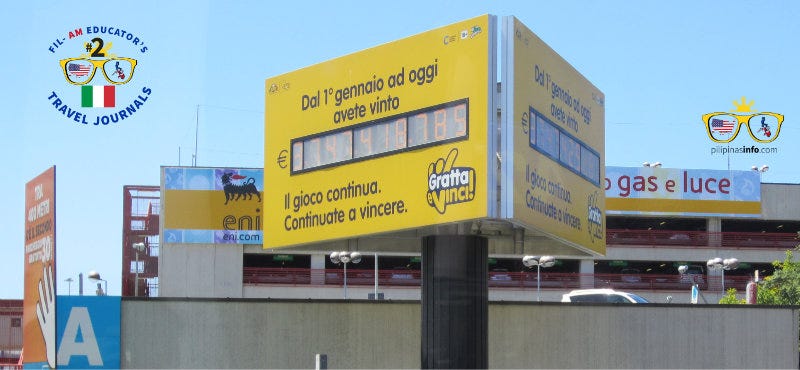Big Impact of Small Difference in Language Comprehension
2012 Italy Travel Observations of a Bilingual SPED Teacher Day No. 2
This is the second post about my trip to Italy in the summer of 2012. It was one of my requirements to complete the GWU Education Specialist Degree that was granted through the partnership of US Education Department, the school district I worked for and George Washington University. Even then, I was writing from the POV of a Filipino Educator teaching in the USA. There are hidden gems in these journal entries worthy to be shared.
In the Philippines, all street signs are in English. Our official language is Tagalog but most of our books and information are in English. In Italy, although English is taught in school, all their signs are in Italian as shown by the picture below which I took right after I went out of the airport.
Using pictures and my limited Spanish, I can assume that the signs are about gasoline. However, as an educator, I warned myself about false cognates and erratic assumptions. It is so easy to assume that you understand another language solely based on pictures and seemingly familiar words. Then after some time, you will discover that you made a grave error.
Lessons for a Non-Italian Speaker
This first exposure to Italian language taught me two lessons: first, Italy, unlike the Philippines, lets its visitors experience and hear their language. Filipinos accommodate visitors by making it easy for them to communicate to everyone in English. Italians may speak in English when necessary but most of their written words are in Italian and it forces tourists to learn some of their phrases. Second, language learners tend to make grave mistakes. I had one such error during my visit at Pisa and which I discussed in day six of this journal. As an educator, it is my duty to help English Language Learners (ELL) in my classroom avoid such mistakes.
What a Difference a Letter Makes
A few minutes after we arrived, we changed and went to the Italian Ministry of Education. Four of us rode a taxi to viale Trastevere 76/a. After a seemingly long ride in narrow, crowded streets, the driver stopped in front of a small merchandise store. The four of us just stared and told the driver it was a mistake. He said it is the address we gave him. Because I am in front, I said 'Ministerio de Education' in my best Spanish accent. He understood and said it in Italian and drove a few buildings away to the right place. Later, when our official meeting was over, I told our speaker our experience and I found out that the driver took us to Trastevere 76 while the Ministry of Education is at Trastevere 76/a. It was a small difference in print but a big difference in location. These small differences are there, seemingly inconsequential but they are not like the small differences in the picture below.
I was fascinated by the elderly Italian man reading a newspaper while the two other persons, who are probably tourists, trying to find their way. The cars were all smaller and can fit in perpendicular parking in a narrow street. On the left is a tabacchi which means tobacco shop wherein you buy tickets for the bus. After my experience with the taxi driver, I decided to take the bus going back to the hotel. Together with another brave classmate, we took bus number 3 back to Hotel Bled.
Bus Ride in Rome
Taking a bus in Rome is a unique experience because the bus driver is separated by a glass cage and cannot be disturbed with any questions. A person with Indian heritage taught us how to validate the ticket and where to alight. The rest of the passengers taught we were locals and even asked me for some directions in Italian.
Help from Kababayans (Countrymen) in Rome
Later, we were expected at the Ristorante Isidoro at Via di San Giovanni in Laterano, 59/a. Three of us overslept and were forced to find the place using a map. We asked a few people on the streets and I was pleasantly surprised to find two Filipino nuns walking our way. I conversed with them in Tagalog and they pointed us to the right direction. For the next few days in Rome, I saw and heard a lot of Filipinos. I took advantage of my heritage and let them guide my way in the historic streets of Rome. In a place where I am not familiar, it was refreshing to hear my native tongue and be able to use it more frequently than I ever used it in the United States. More observations and adventures in Rome in my next post.




